
The Phoridae are a family of small, hump-backed flies resembling fruit flies. Phorid flies can often be identified by their escape habit of running rapidly across a surface rather than taking flight. This behaviour is a source of one of their alternate names, scuttle fly. Another vernacular name, coffin fly, refers to Conicera tibialis. About 4,000 species are known in 230 genera. The most well-known species is cosmopolitan Megaselia scalaris. At 0.4 mm in length, the world's smallest fly is the phorid Euryplatea nanaknihali.
Anevrina luggeri is a species in the family Phoridae, in the order Diptera ("flies").
Dohrniphora incisuralis is a species of scuttle flies.

Dohrniphora is a genus of scuttle flies. There are at least 240 described species in Dohrniphora.
Gymnophora luteiventris is a species of scuttle flies.

Gymnophora is a genus of scuttle flies. There are at least 60 described species in Gymnophora.
Phalacrotophora epeirae is a species of scuttle flies.

Phalacrotophora is a genus of scuttle flies. There are at least 50 described species in Phalacrotophora.
Megaselia globipyga is a species of scuttle flies.
Megaselia rufipes, the coffin fly, is a species of scuttle flies.
Lecanocerus is a genus of scuttle flies. There is at least one described species in Lecanocerus, L. compressiceps.

Megaselia aurea is a species of scuttle flies.
Puliciphora borinquenensis is a species of scuttle flies.

Puliciphora is a genus of scuttle flies. There are at least 110 described species in Puliciphora.

Apocephalus is a genus of ant-decapitating flies. There are at least 300 described species in Apocephalus.

Apocephalus paraponerae is a species of fly in the family Phoridae discovered by Borgmeier in 1958. This species is a parasitoid of the giant tropical ant Paraponera clavata and uses both visual and chemical cues to locate its host. A. paraponerae can locate fighting or injured ants through host-produced alarm pheromones. Female flies are attracted to the ant to feed and oviposit, while males are attracted to feed and locate females for mating. There is some evidence that suggests that A. paraponerae is a cryptic species complex of at least four genetically distinct species.
Chonocephalus is a genus of flies in the family Phoridae.
Metopina is a genus of flies in the family Phoridae.
Neodohrniphora is a genus of flies in the family Phoridae.







